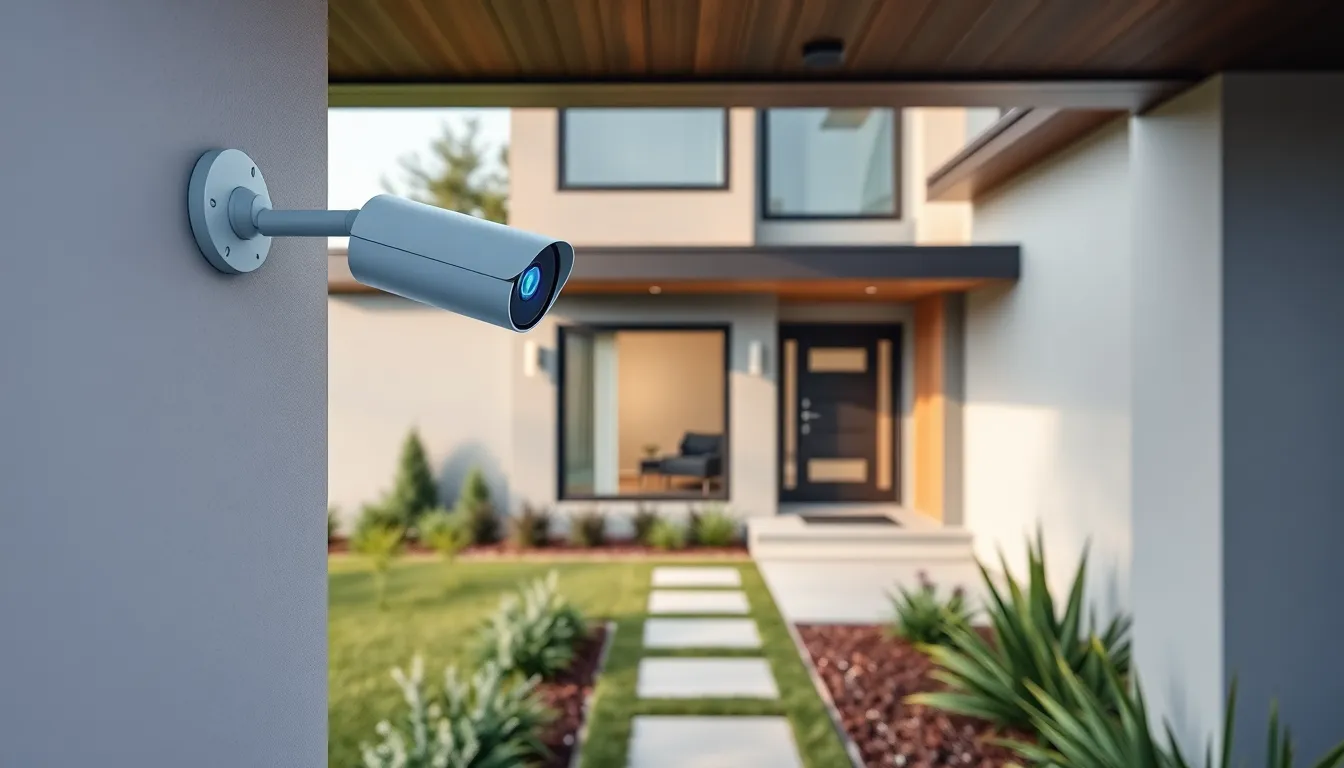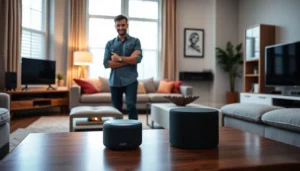Table of Contents
ToggleIn a world where even toasters are getting smarter, smart camera integration is the next big thing that’s capturing everyone’s attention. Imagine a camera that doesn’t just take pictures but also understands the scene, recognizes faces, and even alerts you when your cat decides to stage a midnight heist in the kitchen. It’s not just about snapping selfies; it’s about turning your everyday moments into a high-tech adventure.
As homes evolve into smart ecosystems, integrating cameras into this mix isn’t just a luxury—it’s becoming a necessity. Whether it’s for home security, monitoring your mischievous pets, or simply keeping an eye on the kids, smart cameras are here to make life easier. So, let’s dive into the fascinating world of smart camera integration and discover how these little gadgets are revolutionizing our lives, one pixel at a time.
Overview of Smart Camera Integration
Smart camera integration plays a vital role in contemporary households, enhancing security and convenience. These devices utilize advanced technology to monitor surroundings and provide real-time insights.
Definition and Importance
Smart cameras are sophisticated devices equipped with connectivity features and sensors. They capture images and transmit data, enabling remote access through smartphones or tablets. The importance of smart camera integration lies in its ability to enhance safety, promote peace of mind, and facilitate home monitoring. Families rely on these cameras for preventive measures against potential threats. Businesses also benefit, using smart cameras for improved surveillance and efficiency in operations.
Key Features of Smart Cameras
Smart cameras include several key features that set them apart from traditional cameras. High-definition video capabilities ensure clarity in recordings. Many devices offer night vision, allowing visibility in low-light conditions. Motion detection alerts users of any unusual activity, promoting immediate responses. Some cameras include facial recognition technology, enhancing security measures by identifying familiar faces. Two-way audio functionality facilitates communication, creating interactive monitoring experiences. Cloud storage options enable users to access and save recordings conveniently, ensuring important moments aren’t lost.
Benefits of Smart Camera Integration

Smart camera integration offers significant advantages for modern living. Enhanced security and improved user experience stand out as crucial benefits.
Enhanced Security
Smart cameras boost security by providing real-time monitoring. They alert homeowners immediately when motion is detected, which allows for swift responses to potential threats. Facial recognition features identify known individuals, ensuring that unauthorized access triggers alerts right away. High-definition video capabilities capture clear images, even during low light conditions. Furthermore, cloud storage options enable users to review footage remotely, enhancing situational awareness and evidence collection. Each of these features contributes to a comprehensive security solution that adapts to various needs.
Improved User Experience
User experience receives a major upgrade with smart cameras. Two-way audio functionality fosters communication between homeowners and visitors, allowing for interaction without physical presence. Integration with smart home systems creates a seamless control experience through single applications. Users can access multiple camera feeds simultaneously, simplifying surveillance management. Notifications sent directly to smartphones keep people informed of activity around their homes. Overall, this technology enhances everyday convenience while reinforcing safety and peace of mind.
Applications of Smart Camera Integration
Smart camera integration plays a pivotal role in various sectors, notably in home automation and business environments. These advanced devices enhance both security and convenience.
In Home Automation
Smart cameras streamline home automation by enabling seamless interaction with other smart devices. Homeowners can utilize cameras to monitor living spaces and access real-time video feeds. Equipped with motion detection, these cameras send alerts to smartphones whenever movement occurs. Integration with smart lights adds layers of security during nighttime. Users can activate lights or send audio messages through the camera, deterring potential intruders. Voice commands allow for hands-free operation, making interaction effortless. The capability for remote viewing ensures peace of mind, whether homeowners are at work or on vacation.
In Business and Retail Settings
In business and retail settings, smart camera integration offers enhanced security and operational efficiency. Surveillance systems equipped with advanced analytics identify unusual behavior and generate alerts, enabling timely responses. Cameras can track foot traffic patterns, aiding retailers in optimizing store layouts for improved customer experience. Two-way audio functionality supports communication with customers, enhancing service quality. Furthermore, remote monitoring options allow managers to oversee operations from anywhere, ensuring consistent safety measures. Analyzing video data helps businesses make informed decisions. With cloud storage capabilities, footage retrieval remains straightforward, facilitating audits and compliance reviews.
Challenges and Considerations
Smart camera integration presents several challenges that users must address to maximize benefits.
Privacy Concerns
Privacy issues arise when using smart cameras in residential and commercial settings. Unauthorized access to cameras can lead to surveillance breaches. Individuals often worry about data security and how footage is stored. Compliance with regulations like GDPR becomes crucial when implementing these devices. Implementing strong encryption protects recorded material, while user consent ensures that personal privacy rights remain intact. Transparency about data usage builds trust among users and promotes responsible adoption of smart camera technology.
Technical Limitations
Technical limitations can hinder the effectiveness of smart camera systems. Connectivity issues affect real-time streaming and remote access capabilities. Users might experience difficulties if internet speed fluctuates or bandwidth is limited. Battery life also poses challenges, especially for outdoor cameras that rely on wireless power sources. Compatibility with other smart home devices can create integration barriers, potentially impacting overall functionality. Therefore, selecting systems that can work seamlessly together enhances the user experience and ensures reliable performance.
Future Trends in Smart Camera Integration
Smart camera integration continues to evolve rapidly, shaped by technological innovations that expand their capabilities. This section highlights key trends influencing the future of smart cameras.
Advancements in AI and Machine Learning
AI and machine learning significantly enhance smart camera functionalities, enabling advanced object recognition and real-time analytics. These technologies allow devices to learn from data patterns, improving their ability to distinguish between familiar faces and potential intruders. The integration of behavior analysis further deepens surveillance insights, empowering users to recognize abnormal activities promptly. Resulting notifications become more accurate, minimizing false alarms. Organizations leverage these advancements not only for security but also for marketing insights through analyzing customer behaviors. Enhanced smart cameras can serve specific user needs across different environments.
Increased Connectivity Options
Connectivity advancements create seamless integration opportunities with existing smart home systems. Wi-Fi 6 technology enables faster data transmission, ensuring high-quality video streaming without interruptions. Smart cameras increasingly incorporate technologies like Bluetooth and Zigbee, facilitating smoother interaction with various devices. Many smart cameras now offer compatibility with major voice assistants, allowing hands-free control for users. Enhanced cloud services support data access from multiple devices, promoting ease of use and accessibility. Remote access remains a priority for users managing their security and monitoring needs from afar. As connectivity options expand, smart cameras evolve to become central components within interconnected smart ecosystems.
Smart camera integration is reshaping how individuals and businesses approach security and convenience. With advanced features like real-time monitoring and facial recognition, these devices are becoming essential tools in modern living. They not only enhance safety but also provide users with peace of mind through seamless connectivity and remote access.
As technology continues to evolve, the capabilities of smart cameras will expand, making them even more integral to smart home ecosystems. Addressing privacy concerns and ensuring compatibility will be crucial as users embrace these innovations. Embracing smart camera integration today means stepping into a safer and more connected future.




